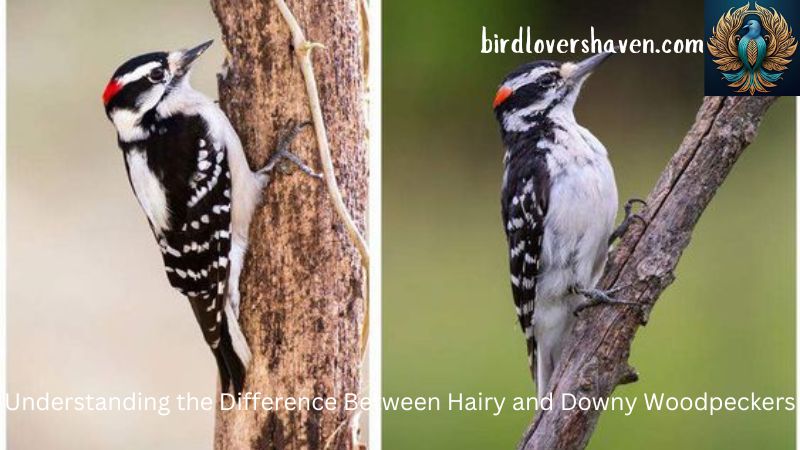Bird Species & Identification
Understanding the Difference Between Hairy and Downy Woodpeckers
Birdwatching enthusiasts often encounter two woodpecker species that look remarkably similar: the Hairy Woodpecker (Picoides villosus) and the Downy Woodpecker (Picoides pubescens). These two species are common throughout North America and are often found in similar habitats, making them frequent visitors to backyard feeders.
Despite their striking resemblance, there are several key differences that can help birdwatchers distinguish between them. This article Bird Lovers Haven will explore these Difference Between Hairy and Downy Woodpecker in detail, covering aspects such as size, physical features, behavior, habitat preferences, and vocalizations.
Table of contents
TogglePhysical Differences
Size Comparison
One of the most noticeable differences between the Hairy and Downy Woodpeckers is their size:
- Hairy Woodpecker: The Hairy Woodpecker is the larger of the two species, typically measuring around 9 to 10 inches in length with a wingspan of about 15 to 17 inches. This makes it comparable in size to a robin.
- Downy Woodpecker: The Downy Woodpecker is smaller, measuring about 6 to 7 inches in length with a wingspan of 10 to 12 inches, closer to the size of a sparrow.
While size is a key differentiator, it can be challenging to gauge in the field unless both species are observed side by side. Therefore, birdwatchers often rely on other physical features to tell them apart.
Bill Size and Shape
The bill is one of the most reliable features for distinguishing between the two species:
- Hairy Woodpecker: The Hairy Woodpecker has a longer, more robust bill that is nearly as long as its head from base to tip. This strong bill is well-suited for excavating deeper into wood to find insects.
- Downy Woodpecker: The Downy Woodpecker, in contrast, has a shorter and more delicate bill, typically about one-third the length of its head. This smaller bill is adapted for foraging on the surface of bark and in smaller crevices.
Observing the bill size and shape can be especially helpful when the two species are not directly compared, as it is a distinctive feature that is easily visible through binoculars.
Tail Feather Patterns
The tail feathers of these woodpeckers also provide clues to their identification:
- Hairy Woodpecker: The outer tail feathers of the Hairy Woodpecker are usually pure white, without any spotting or barring.
- Downy Woodpecker: The Downy Woodpecker, however, often has black spots or bars on the outer tail feathers, which can be seen when the bird is perched.
This tail feather pattern is a subtle but reliable characteristic that can aid in identification, especially when other features are less visible.
Body Proportions and Posture
The overall body proportions and posture of the Hairy and Downy Woodpeckers can also differ slightly:
- Hairy Woodpecker: The Hairy Woodpecker tends to have a more robust, straight-backed appearance. Its larger size and longer bill give it a slightly more imposing silhouette.
- Downy Woodpecker: The Downy Woodpecker often appears more delicate and compact, with a slightly puffier look, particularly around the head and neck. It also tends to perch with a slightly more hunched posture.
While these differences are subtle and may require practice to recognize, they can become more apparent with experience.
Behavioral Differences
Foraging Habits
Both the Hairy and Downy Woodpeckers are adept foragers, but they have distinct preferences in how and where they search for food:
- Hairy Woodpecker: Hairy Woodpeckers tend to forage on larger tree trunks and thicker branches, where their stronger bills can be used to chisel into wood in search of insects like beetles and larvae. They are often seen working their way methodically up and down tree trunks, tapping and drilling into the bark.
- Downy Woodpecker: Downy Woodpeckers, on the other hand, are more often found on smaller branches, twigs, and even plant stems. They are less likely to drill deeply into wood and instead focus on gleaning insects from the surface of bark or picking at insect galls and plant material.
This difference in foraging behavior means that Downy Woodpeckers are more likely to be seen in shrubby areas or lower in trees, while Hairy Woodpeckers are typically found higher up on larger trees.
Interactions with Other Birds
The interactions of these woodpeckers with other bird species can also provide insight into their identification:
- Hairy Woodpecker: Being larger and more dominant, Hairy Woodpeckers are often more assertive at feeders and may chase away smaller birds, including Downy Woodpeckers, to claim a feeding spot.
- Downy Woodpecker: Downy Woodpeckers are generally more social and tolerant of other small birds. They are often seen feeding alongside species like chickadees, nuthatches, and titmice, and are less likely to engage in aggressive behavior.
Observing the social dynamics at your feeder can offer additional clues to which species you are observing.

Habitat Preferences
Geographic Range
Both the Hairy and Downy Woodpeckers are widespread across North America, but there are some differences in their preferred habitats:
- Hairy Woodpecker: Hairy Woodpeckers are more commonly found in mature forests with large, old trees. They are often associated with deciduous and mixed woodlands, as well as coniferous forests in the northern parts of their range. They can also be found in parks, wooded suburbs, and forest edges.
- Downy Woodpecker: Downy Woodpeckers are more adaptable and can be found in a wider variety of habitats, including woodlands, orchards, urban parks, gardens, and even reed beds. They are more likely to be seen in suburban areas and are frequent visitors to backyard feeders.
While both species can be found in similar habitats, Downy Woodpeckers are generally more versatile and more likely to be encountered in residential areas.
Nesting and Breeding
Both species of woodpeckers are cavity nesters, excavating holes in dead or dying trees to create nests:
- Hairy Woodpecker: Hairy Woodpeckers prefer to nest in larger trees and often select sites higher off the ground, where their larger size provides them with a greater reach for excavation.
- Downy Woodpecker: Downy Woodpeckers may nest in smaller trees or even in man-made structures like fence posts or birdhouses. They tend to nest closer to the ground, which makes them more adaptable to urban and suburban environments.
These nesting preferences reflect the overall habitat differences between the two species and can sometimes help in identifying them during the breeding season.
Vocalizations
Calls and Drumming
Both the Hairy and Downy Woodpeckers produce a variety of vocalizations and drumming patterns that can help in their identification:
- Hairy Woodpecker: The call of the Hairy Woodpecker is a sharp, piercing “peek” sound, which is louder and more emphatic than that of the Downy. Their drumming is also more forceful and typically consists of a steady, rapid series of taps that last longer and are more evenly spaced.
- Downy Woodpecker: The Downy Woodpecker’s call is softer and more of a “pik” or “pik-pik” sound. Their drumming is faster but with shorter bursts, often described as a rapid roll of taps that trails off more quickly than the Hairy’s drumming.
Learning to recognize these vocal differences can be particularly useful when the birds are not visible, as their sounds can often be heard from a distance.
Misidentification and Overlapping Traits
Common Mistakes in Identification
Despite the differences outlined above, the Hairy and Downy Woodpeckers are frequently misidentified, especially by novice birdwatchers. Some common reasons for misidentification include:
- Size illusion: Without a direct comparison, the size difference between the two species can be difficult to gauge, leading to confusion.
- Overlapping habitats: Since both species can be found in similar environments, birdwatchers may assume they are observing one species when it is actually the other.
- Similar plumage: The nearly identical black and white plumage patterns can make visual identification challenging, particularly when birds are seen from a distance or in poor lighting.
Tips for Accurate Identification
To improve accuracy in identifying these woodpeckers, consider the following tips:
- Observe multiple features: Rather than relying on a single characteristic, look at a combination of features, including size, bill shape, tail patterns, and behavior.
- Use reference materials: Carrying a field guide or using a bird identification app can help you compare the birds you see with known images and descriptions.
- Practice in different environments: Spend time observing these woodpeckers in various habitats to become familiar with their behaviors and characteristics in different contexts.
Conclusion
While the Hairy and Downy Woodpeckers share many similarities, understanding the differences between them can greatly enhance your birdwatching experience. By paying attention to size, bill shape, tail patterns, and behavior, birdwatchers can confidently distinguish between these two common woodpeckers. Whether you are observing them in the wild or at your backyard feeder, recognizing the unique traits of each species adds depth to your understanding of the natural world.
As with all aspects of birdwatching, practice and patience are key. Over time, you’ll develop a keener eye for the subtle differences that set these woodpeckers apart, allowing you to enjoy and appreciate their presence even more.





